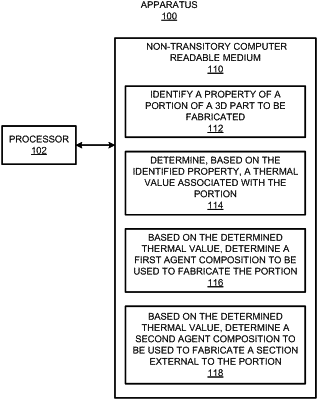| CPC B29C 64/393 (2017.08) [B29C 64/165 (2017.08); B33Y 10/00 (2014.12); B33Y 30/00 (2014.12); B33Y 50/02 (2014.12)] | 14 Claims |

|
1. An apparatus comprising:
a processor; and
a non-transitory computer readable medium on which is stored instructions that when executed by the processor, are to cause the processor to:
identify a color and a geometry of a boundary portion of a three-dimensional (3D) object to be fabricated via an additive manufacturing process in which build material particles are deposited on a layer-by-layer basis and selectively fused;
determine, based on the color and the geometry of the boundary portion—a temperature associated with the boundary portion and corresponding to a thermal response of the build material particles and one or more colorants, a fusing agent, and/or a detailing agent applied thereon to applied energy;
based on the temperature determined based on the color and the geometry of the boundary portion,
determine a first agent composition of the one or more colorants, the fusing agent, and/or the detailing agent to be used to fabricate the boundary portion, and
a second agent composition of the one or more colorants, the one or more fusing agents, and the one or more detailing agents to be used to fabricate an external section adjacent to the boundary portion and that the is not part of the 3D object; and
cause the 3D object to be fabricated via the additive manufacturing process using the determined first agent composition for the boundary portion and the determined second agent composition for the external section,
wherein the first agent composition and the second agent composition are determined such that the boundary portion and the external section are fabricated to have the color of the boundary portion while maintaining the external section separate from the boundary portion such that the external section is not fused with the boundary portion.
|